
Two separate research teams have succeeded in generating blood stem cells using completely different procedures. One team was led by stem cell biologist Dr. George Q. Daley of Harvard Medical School and Boston Children’s Hospital. The other team was spearheaded by Dr. Shahin Rafii of the Weill Cornell Medicine’s Ansary Stem Cell Institute in New York.
In both cases, reprogrammed blood stem cells were able to successfully produce blood cells when implanted into mice. And if either or both procedures turn out to be viable for humans, a future where blood donors will no longer be needed may soon be in the horizon because science has provided us with a way to produce unlimited blood supply.
Stem cells are specially programmed cells that are responsible for creating all of the body’s other cells. There are two types of stem cells — embryonic and adult. Embryonic stem cells are located — you guessed it — in the embryo where they stay before they start to specialise. Adult stem cells are the ones used to repair and replace worn out or old cells.
Those are the natural types. There’s another type, though. They’re called induced pluripotent stem cells (iPS cells for short). Unlike the first two types, iPS cells aren’t naturally present. They’re actually adult stem cells that were converted back to their primitive state, which means they can be ‘coaxed’ to turn into any type of cell.
Dr. Daley and his team chose to use both embryonic stem cells and iPS cells for their research. Using a combination of proteins, they ‘coaxed’ the cells to turn into hemogenic endothelium — a kind of embryonic tissue that eventually turns into blood stem cells. Next, they tested several transcription factors — genes that tell other genes what to do — until they came up with the combination (specifically: ERG, HOXA5, HOXA9, HOXA10, LCOR, RUNX1, and SPI1) that pushed the hemogenic endothelium into a blood-forming or blood stem cell state. They then injected those modified cells into the bone marrow of their mice subjects. After several weeks, portions of the mice’s blood and bone marrow developed different types of blood cells, including red blood cells, white blood cells, and even immune cells.
As Daley described the feat: “We’re tantalizingly close to generating bona fide human blood stem cells in a dish.”
On the other hand, Rafii and his team chose a different route. They didn’t make use of iPS cells. Instead, they created true blood stem cells, starting off by extracting stem cells from the blood vessel lining of mature mice. Next, they inserted transcription factors (Fosb, Gfi1, Runx1, and Spi1) into the genomes of the extracted cells, then kept these cells in Petri dishes designed to replicate the environment within human blood vessels.
Over time, the cells turned into blood stem cells and multiplied. They then injected those stem cells into mice treated with radiation (which meant most of their blood and immune cells were gone). The stem cells regenerated not just the blood, but the immune cells too. Consequently, the mice recovered and went on to live for over 1.5 years in the lab.
As described by Rafii, the procedure they used is similar to a ‘direct aeroplane flight’, while Daley’s is like a flight that took a detour prior to reaching its ultimate destination. Doing away with the iPS part kind of makes Rafii’s method slightly better than Daley’s because it minimizes the threat of tumors forming or the body rejecting the stem cells, which is a typical reaction that iPS cells might cause. But if Daley’s team is able to refine their process to eliminate this risk, then that will level the playing field, so to speak.
Whatever happens from here on, both procedures are nonetheless considered significant breakthroughs. And even though it’s not yet certain which method will turn out to be the better one for humans, what’s clear is that both methods have the potential to be game-changers when it comes to any kind of treatment involving blood infusion and transfusion.
Both studies have been published in the journal Nature, with Daley’s under the title ‘Haematopoietic stem and progenitor cells from human pluripotent stem cells’ and Rafii’s under the title ‘Conversion of adult endothelium to immunocompetent haematopoietic stem cells’.
- Bulenox: Get 45% to 91% OFF ... Use Discount Code: UNO
- Risk Our Money Not Yours | Get 50% to 90% OFF ... Use Discount Code: MMBVBKSM
Disclaimer: This page contains affiliate links. If you choose to make a purchase after clicking a link, we may receive a commission at no additional cost to you. Thank you for your support!

I pray that Dr. Rafii is successful as their team’s approach removes the contemporary moral issue of interrupting and ending the development of an embryo. These are hard things to think through but they deserve a lot of thought and respectful discussion.
Oh goodie, now we can stop giving away our blood to the Red Cross and other bogus “non-profit” organizations who beg and plead us to donate an hour of our time and a pint of precious body fluid for free, while they sell it to hospitals for close to $400. Even plasma donors get something, but all blood donors get is a bag of cookies and warm fuzzy feeling that they are helping someone else. Biggest scam in history, whole blood donation.